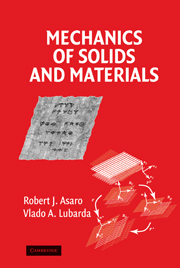Book contents
- Frontmatter
- Contents
- Preface
- PART 1 MATHEMATICAL PRELIMINARIES
- PART 2 CONTINUUM MECHANICS
- PART 3 LINEAR ELASTICITY
- PART 4 MICROMECHANICS
- PART 5 THIN FILMS AND INTERFACES
- PART 6 PLASTICITY AND VISCOPLASTICITY
- PART 7 BIOMECHANICS
- 32 Mechanics of a Growing Mass
- 33 Constitutive Relations for Membranes
- PART 8 SOLVED PROBLEMS
- Bibliography
- Index
33 - Constitutive Relations for Membranes
Published online by Cambridge University Press: 06 July 2010
- Frontmatter
- Contents
- Preface
- PART 1 MATHEMATICAL PRELIMINARIES
- PART 2 CONTINUUM MECHANICS
- PART 3 LINEAR ELASTICITY
- PART 4 MICROMECHANICS
- PART 5 THIN FILMS AND INTERFACES
- PART 6 PLASTICITY AND VISCOPLASTICITY
- PART 7 BIOMECHANICS
- 32 Mechanics of a Growing Mass
- 33 Constitutive Relations for Membranes
- PART 8 SOLVED PROBLEMS
- Bibliography
- Index
Summary
In this chapter we consider the behavior of essentially 2D membranes. The membranes may be linear or nonlinear and are generally considered to undergo arbitrarily large deformations. More specifically, the membranes considered here are modeled after biological membranes such as those that comprise cell walls or the layers that exist within biomineralized structures, e.g., shells or teeth. The discussion is preliminary and meant to provide a brief introduction to the basic concepts involved in the constitutive modeling of such structures.
Biological Membranes
Figure 33.1a illustrates an idealized view of the red blood cell that shows its hybrid structure consisting of an outer bilipid membrane and an attached cytoskeleton; Fig. 33.1b shows a micrograph of a section of the cytoskeleton that is illustrated schematically in Fig. 33.1a. The cell membrane is a hybrid, i.e., composite structure consisting of an outer bilipid layer that is supported (i.e., reinforced) by a network attached to it on the cytoplasmic side, which is on the inside of the cell. The cytoskeleton is built up from mostly tetramers, and higher order polypeptides, of the protein spectrin attached at actin nodes. We note that the spectrin network has close to a sixfold nodal coordination. It has been known that the nonlinear elastic properties of the membrane depend sensitively on the details of the topology that includes, inter alia, nodal coordination, spectrin segment length, and the statistical distribution of such topological parameters.
- Type
- Chapter
- Information
- Mechanics of Solids and Materials , pp. 633 - 640Publisher: Cambridge University PressPrint publication year: 2006



